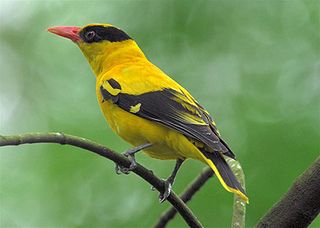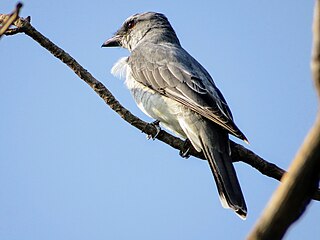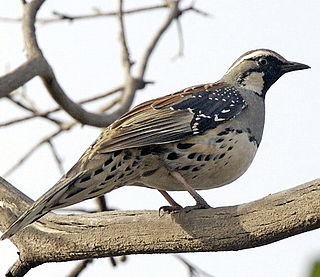
Orioles are colourful Old World passerine birds in the genus Oriolus, the type genus of the corvoidean family Oriolidae. They are not closely related to the New World orioles, which are icterids that belong to the superfamily Passeroidea.

Psophodidae is a family of passerine birds native to Australia and nearby areas. It has a complicated taxonomic history and different authors vary in which birds they include in the family. In the strictest sense, it includes only the five or six species of whipbirds and wedgebills, but some authors also include the quail-thrushes (Cinclosoma), eight species of ground-dwelling birds found in Australia and New Guinea, and the jewel-babblers (Ptilorrhoa), three or four species found in rainforest in New Guinea. Others place them in their own family, the Cinclosomatidae. The Malaysian rail-babbler was formerly sometimes placed in this family, which would then be called Eupetidae.

The genus Paradisaea consists of six species of birds-of-paradise. The genus is found on the island of New Guinea as well as the nearby islands groups of the Aru Islands, D'Entrecasteaux Islands and Raja Ampat Islands. The species inhabit a range of forest types from sea level to mid-montane forests. Several species have highly restricted distributions, and all species have disjunct distributions. A 2009 study examining the mitochondrial DNA of the family found that the Paradisaea birds-of-paradise were in a clade with the genus Cicinnurus. It showed that the blue bird-of-paradise was a sister taxon to all the other species in this genus.

The large cuckooshrike is a species of cuckooshrike found in the Indian Subcontinent and depending on the taxonomic treatment used, Southeast Asia. The species has had a long and varied taxonomic treatment, being closely related to forms across Southeast Asia, with some authors using the name Indian cuckooshrike. The species and subspecies classifications vary widely across sources and are yet to be resolved unambiguously.

The genus Paradigalla consists of two species of birds-of-paradise. Both are medium-sized black birds with blue and yellow facial wattles.

A shrikethrush, also spelled shrike-thrush, is any one of eleven species of songbird that is a member of the genus Colluricincla. They have nondescript, predominantly brown or grey, plumage, but are accomplished singers, their calls described as "strong, mellow and beautiful." Shrikethrushes are generally insectivorous, though have been recorded eating molluscs and berries. They build cup-shaped nests in the forks of trees.

The Sangihe whistler or Sangihe shrikethrush is a species of bird in the family Pachycephalidae. It is endemic to Sangihe Island in Indonesia. Its natural habitat is subtropical or tropical moist montane forests. Specifically, it lives in ridgetop forests with large trees and full canopy cover.

The pygmy cuckooshrike is a species of bird in the cuckooshrike family Campephagidae. It is endemic to the Indonesian island of Sulawesi. Its natural habitat is subtropical or tropical moist montane forests.

McGregor's cuckooshrike or the sharp-tailed cuckooshrike, is a species of bird in the family Campephagidae. It is endemic to Mindanao island (Philippines).

The maroon-backed whistler is a species of bird in the family Pachycephalidae. It is endemic to Sulawesi, Indonesia. Its natural habitat is subtropical or tropical moist montane forests. Some authorities have classified the maroon-backed whistler in the genus Pachycephala. Alternate names include the Rano Rano whistler and Raven's whistler.

The melampittas are a family, Melampittidae, of New Guinean birds containing two enigmatic species. The two species are found in two genera, the greater melampitta in the genus Megalampitta and the lesser melampitta in the genus Melampitta. They are little studied and before being established as a family in 2014 their taxonomic relationships with other birds were uncertain, being considered at one time related variously to the pittas, Old World babblers and birds-of-paradise.

The black-and-crimson oriole is a species of bird in the family Oriolidae.

The black oriole is a species of bird in the family Oriolidae. It is endemic to the island of Borneo. One of the least known of the orioles, its distribution range is restricted to Sarawak in Borneo. Along with the black-and-crimson, maroon, and silver orioles, it belongs to a clade of red and black orioles. The binomial name is after Charles Hose who collected the first specimen of the species on Mount Dulit.

The silver oriole is a species of bird in the family Oriolidae. It breeds in southern China and winters in mainland Southeast Asia.

The maroon oriole is a species of bird in the family Oriolidae. It is found in Southeast Asia.

The goldenface is a species of passerine bird endemic to New Guinea. It is the only species (monotypic) within the genus Pachycare.

The Gilbert's whistler is a monotypic species of bird endemic to Australia, scattered in semi-arid zones of southern Australia.

Cinclosomatidae is a family of passerine birds native to Australia and New Guinea. It has a complicated taxonomic history and different authors vary in which birds they include in the family. It includes the quail-thrushes and jewel-babblers.

Edolisoma is a genus of birds in the cuckooshrike family Campephagidae that are native to the Central Indo-Pacific region, Australia and New Guinea.

Ceblepyris is a genus of African passerine birds in the cuckooshrike family Campephagidae.



























